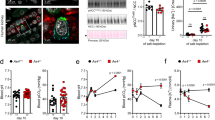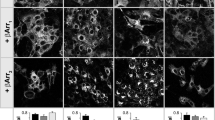Abstract
Growth factors raise intracellular pH (pHi) by stimulating Na+/H+ exchange in the absence of HCO−3 (refs 1-4). In mutant cells that lack the Na+/H+ exchange activity, this alkalinization does not occur, and the cells do not proliferate without artificial elevation of pHi5,6. It has therefore been widely suggested that an early pHi increase is a necessary signal for mitogenesis. In the presence of HCO−3 however, growth factors fail to raise pHi in A431 cells7, renal mesangial cells8 and 3T3 fibroblasts9. In mesangial cells, arginine vasopressin (AVP) raises pHi in the absence of HCO+3, but lowers it when HCO−3 is present; growth is stimulated under both conditions8. We report here that, in the presence of HCO−3, AVP stimulates two potent HCO−3 transporters, as well as the Na+/H+ exchanger. These are the Na+-depen-dent and Na+-independent Cl−/HCO−3 exchangers. Our results indicate that AVP causes acidification in the presence of HCO−3 because, at the resting pHi, it stimulates Na+-independent Cl−/HCO−3exchange (which lowers pHi) more than it stimulates the sum of Na+/H+ exchange and Na+-dependent Cl−/HCO−3 exchange (both of which raise pHi). The stimulation of three acid-base transporters by the growth factor AVP greatly enhances the ability of the cell to regulate pHi.
This is a preview of subscription content, access via your institution
Access options
Subscribe to this journal
Receive 51 print issues and online access
$199.00 per year
only $3.90 per issue
Buy this article
- Purchase on Springer Link
- Instant access to full article PDF
Prices may be subject to local taxes which are calculated during checkout
Similar content being viewed by others
References
Schuldiner, S. & Rozengurt, E. Proc. natn. Acad. Sci. U.S.A. 79, 7778–7782 (1982).
Moolenaar, W. H., Tsien, R. Y., van der Saag, P. T. & de Laat, S. W. Nature 304, 645–648 (1983).
Rothenberg, P., Glaser, L., Schlesinger, P. & Cassel, D. J. biol. Chem. 20, 12644–12653 (1983).
Grinstein, S., Cohen, S., Goetz, J. D., Rothstein, A. & Gelfand, E. W. Proc. natn. Acad. Sci. U.S.A. 82, 1429–1433 (1985).
Pouyssegur, J., Sardet, C., Franchi, A., L'Allemain, G. & Paris, S. Proc. natn. Acad. Sci. U.S.A. 81, 4833–4837 (1984).
Pouyssegur, J., Franchi, A., L'Allemain, G. L. & Paris, S. FEBS Lett. 190, 115–119 (1985).
Cassel, D., Whiteley, B., Zhuang, Y. X. & Glaser, L. J. Cell Physiol. 122, 178–186 (1985).
Ganz, M. B., Boyarsky, G., Boron, W. F. & Sterzel, R. B. Am. J. Physiol. 254, F787–F794 (1988).
Moolenaar, W. H. J. biol. Chem. (in the press).
Boyarsky, G., Ganz, M. B., Sterzel, B. & Boron, W. F. Am. J. Physiol. 255, C844–C856 (1988).
Boyarsky, G., Ganz, M. B., Sterzel, B. & Boron, W. F. Am. J. Physiol. 255, C857–C869 (1988).
Boron, W. F. & De Weer, P. J. gen. Physiol. 67, 91–112 (1976).
Boron, W. F. & Boulpaep, E. L. J. gen. Physiol. 81, 53–94 (1983).
Roos, A. & Boron, W. F. Physiol. Rev. 61, 296–434 (1981).
Lovett, D. H., Ryan, J. L. & Sterzel, R. B. J. Immun. 131, 2830–2836 (1983).
Rink, T. J., Tsien, R. Y. & Pozzan, T. J. Cell Biol. 95, 189–196 (1982).
Thomas, J. A., Buchsbaum, R. N., Zimniak, A. & Racker, E. Biochemistry 81, 2210–2218 (1979).
Author information
Authors and Affiliations
Rights and permissions
About this article
Cite this article
Ganz, M., Boyarsky, G., Sterzel, R. et al. Arginine vasopressin enhances pHi regulation in the presence of HCO−3 by stimulating three acid-base transport systems. Nature 337, 648–651 (1989). https://doi.org/10.1038/337648a0
Received:
Accepted:
Issue Date:
DOI: https://doi.org/10.1038/337648a0
This article is cited by
-
Stimulation of electrogenic intestinal dipeptide transport by the glucocorticoid dexamethasone
Pflügers Archiv - European Journal of Physiology (2009)
-
Transport activities involved in intracellular pH recovery following acid and alkali challenges in rat brain microvascular endothelial cells
Pflügers Archiv - European Journal of Physiology (2008)
-
Role of the serum and glucocorticoid inducible kinase SGK1 in glucocorticoid stimulation of gastric acid secretion
Pflügers Archiv - European Journal of Physiology (2007)
-
Mitochondria are not required for death receptor-mediated cytosolic acidification during apoptosis
Apoptosis (2007)
-
Calcium signaling phenomena in heart diseases: a perspective
Molecular and Cellular Biochemistry (2007)
Comments
By submitting a comment you agree to abide by our Terms and Community Guidelines. If you find something abusive or that does not comply with our terms or guidelines please flag it as inappropriate.



